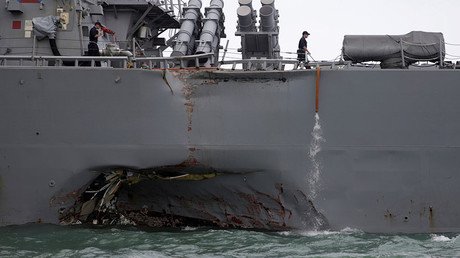US Navy announces 'operational pause' after McCain incident
The US Navy has called for an “operational pause” in all fleets following the collision of the guided missile destroyer USS John S McCain with a merchant ship off Singapore. The Navy also ordered a review of “root causes” of a series of incidents at sea.
“This is the second collision in three months, and the last in a series of incidents in the Pacific theater. This trend demands more forceful action,” Chief of Naval Operations (CNO) Admiral John Richardson said on Monday. “As such, an operational pause will be taken in all our fleets around the world.”
The stoppage will last between 24 and 48 hours, at the discretion of individual fleet commanders, Richardson clarified.
#BREAKING: Statement from @CNORichardson on #USSJohnSMcCain collision. Operational pause and comprehensive reviewed directed. pic.twitter.com/OQFy0RGEAu
— U.S. Navy (@USNavy) August 21, 2017
Five sailors were injured and 10 were reported missing after the guided missile destroyer USS John S. McCain was struck by an oil tanker near Singapore on Sunday evening. The ship suffered “significant damage to the hull” and had to put in for repairs.
An international search-and-rescue operation is underway to find the missing sailors.
There was no indication that the collision was intentional, Richardson told reporters at the Pentagon on Monday.
Ordering the pause in operations, Admiral Richardson said he wanted fleet commanders to get together with their leaders and commanders “to ensure we are taking all appropriate and immediate actions to ensure safe and secure operations around the world.”
The stand-down will be accompanied by a CNO review of 7th Fleet operations, in addition to the investigations into the incidents involving the Fitzgerald and the McCain that are already underway.
Richardson has directed Admiral Philip Davidson, head of the Navy Fleet Forces, to lead the review. He will have full access to the Navy's Office of the Inspector General and a "diverse" team of officers and non-Navy personnel to aide with the probe.
According to Richardson, the review will look at training and certification of fleet forces in operations and war fighting, trends in personnel, maintenance and equipment, and a review of “tactical proficiency.”
Commissioned in 1994, the McCain is named after Senator John McCain’s (R-Arizona) namesake father and grandfather, who were both Navy admirals. The destroyer is based at the 7th Fleet’s home port in Yokosuka, Japan. Earlier this month, it sailed within 12 miles of Mischief Reef in the disputed Spratly archipelago in the South China Sea, as part of a US “freedom of navigation” operations in the region.
In potential collision situations, it is the responsibility of the smaller, more maneuverable vessel to get out of the way, US Navy veteran and Defense News correspondent David Larter told the National Public Radio.
"There are so many safeguards in place to avoid these collisions that it's kind of baffling," Larter told NPR.
In June, another Arleigh Burke-class destroyer, the USS Fitzgerald, was struck by a Philippine-flagged container ship some 56 nautical miles southwest of Yokosuka, Japan. Seven sailors were killed.
Twelve crew members have been punished by the Navy over that incident, including the Fitzgerald's commander and executive officer.













